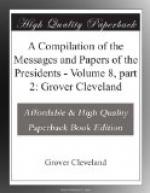If this modification of the President’s proposal should not prove acceptable, Mr. Bankhead observed, the only remaining way of adjusting the difference would be to abandon altogether the attempt to draw a line in conformity with the words of the treaty and to fix upon a convenient line, to be drawn according to equitable principles and with a view to the respective interests and the convenience of the two parties. He stated that His Majesty’s Government were perfectly ready to treat for such a line, and conceived that the natural features of the disputed territory would afford peculiar facilities for drawing it; that His Majesty’s Government would therefore propose an equal division of the territory in dispute between Great Britain and the United States, and that the general outline of such a division would be that the boundary between the two States should be drawn due north from the head of St. Croix River till it intersected the St. John; thence up the bed of the St. John to the southernmost source of that river, and from that point it should be drawn to the head of the Connecticut River in such manner as to make the northern and southern allotments of the divided territory as nearly as possible equal to each other in extent.
In reply to the preceding note the Secretary, under date of February 29, 1836, expressed the President’s regret to find that His Britannic Majesty’s Government adhered to its objection to the appointment of a commission to be chosen in either of the modes heretofore proposed by the United States and his conviction that the proposition on which it was founded, “that the river question was a treaty construction only,” although repeated on various occasions by Great Britain, was demonstrably untenable, and, indeed, only plausible when material and most important words of description in the treaty are omitted in quoting from that instrument. He said that while His Majesty’s Government maintain their position agreement between the United States and Great Britain on this point was impossible; that the President was therefore constrained to look to the new and conventional line offered in Mr. Bankhead’s




